+ データを開く
データを開く
- 基本情報
基本情報
| 登録情報 | データベース: PDB / ID: 5z8y | |||||||||
|---|---|---|---|---|---|---|---|---|---|---|
| タイトル | Crystal structure of human LRRTM2 in complex with Neurexin 1beta | |||||||||
 要素 要素 |
| |||||||||
 キーワード キーワード | CELL ADHESION / Synapse / leucine-rich repeat / synaptic organizer | |||||||||
| 機能・相同性 |  機能・相同性情報 機能・相同性情報protein-containing complex assembly involved in synapse maturation / : / positive regulation of presynaptic active zone assembly / protein complex involved in cell-cell adhesion / guanylate kinase-associated protein clustering / positive regulation of neuromuscular synaptic transmission / neuronal signal transduction / neuroligin clustering involved in postsynaptic membrane assembly / type 1 fibroblast growth factor receptor binding / trans-synaptic protein complex ...protein-containing complex assembly involved in synapse maturation / : / positive regulation of presynaptic active zone assembly / protein complex involved in cell-cell adhesion / guanylate kinase-associated protein clustering / positive regulation of neuromuscular synaptic transmission / neuronal signal transduction / neuroligin clustering involved in postsynaptic membrane assembly / type 1 fibroblast growth factor receptor binding / trans-synaptic protein complex / negative regulation of filopodium assembly / gephyrin clustering involved in postsynaptic density assembly / cerebellar granule cell differentiation / postsynaptic density protein 95 clustering / postsynaptic membrane assembly / gamma-aminobutyric acid receptor clustering / presynaptic membrane assembly / neuroligin family protein binding / neurexin family protein binding / synaptic vesicle clustering / positive regulation of fibroblast growth factor receptor signaling pathway / receptor localization to synapse / neuron cell-cell adhesion / NMDA glutamate receptor clustering / calcium-dependent cell-cell adhesion / vocalization behavior / regulation of postsynaptic density assembly / protein localization to synapse / negative regulation of receptor internalization / AMPA selective glutamate receptor signaling pathway / positive regulation of synapse assembly / NMDA selective glutamate receptor signaling pathway / heterophilic cell-cell adhesion / Neurexins and neuroligins / postsynaptic specialization membrane / positive regulation of phospholipase C-activating G protein-coupled receptor signaling pathway / adult behavior / excitatory synapse / social behavior / endocytic vesicle / positive regulation of excitatory postsynaptic potential / positive regulation of synaptic transmission, glutamatergic / axonal growth cone / synapse assembly / cell adhesion molecule binding / neuron projection morphogenesis / cellular response to calcium ion / hippocampal mossy fiber to CA3 synapse / positive regulation of synaptic transmission, GABAergic / learning / positive regulation of protein localization to plasma membrane / neuromuscular junction / establishment of protein localization / postsynaptic density membrane / synapse organization / GABA-ergic synapse / Schaffer collateral - CA1 synapse / long-term synaptic potentiation / neuron projection development / calcium-dependent protein binding / transmembrane signaling receptor activity / presynapse / presynaptic membrane / angiogenesis / nuclear membrane / vesicle / positive regulation of ERK1 and ERK2 cascade / positive regulation of phosphatidylinositol 3-kinase/protein kinase B signal transduction / signaling receptor binding / negative regulation of gene expression / neuronal cell body / positive regulation of gene expression / glutamatergic synapse / cell surface / endoplasmic reticulum / signal transduction / extracellular space / metal ion binding / plasma membrane 類似検索 - 分子機能 | |||||||||
| 生物種 |  Homo sapiens (ヒト) Homo sapiens (ヒト) | |||||||||
| 手法 |  X線回折 / X線回折 /  シンクロトロン / シンクロトロン /  分子置換 / 解像度: 3.4 Å 分子置換 / 解像度: 3.4 Å | |||||||||
 データ登録者 データ登録者 | Yamagata, A. / Fukai, S. | |||||||||
| 資金援助 |  日本, 2件 日本, 2件
| |||||||||
 引用 引用 |  ジャーナル: Nat Commun / 年: 2018 ジャーナル: Nat Commun / 年: 2018タイトル: Structural insights into modulation and selectivity of transsynaptic neurexin-LRRTM interaction. 著者: Yamagata, A. / Goto-Ito, S. / Sato, Y. / Shiroshima, T. / Maeda, A. / Watanabe, M. / Saitoh, T. / Maenaka, K. / Terada, T. / Yoshida, T. / Uemura, T. / Fukai, S. | |||||||||
| 履歴 |
|
- 構造の表示
構造の表示
| 構造ビューア | 分子:  Molmil Molmil Jmol/JSmol Jmol/JSmol |
|---|
- ダウンロードとリンク
ダウンロードとリンク
- ダウンロード
ダウンロード
| PDBx/mmCIF形式 |  5z8y.cif.gz 5z8y.cif.gz | 820.8 KB | 表示 |  PDBx/mmCIF形式 PDBx/mmCIF形式 |
|---|---|---|---|---|
| PDB形式 |  pdb5z8y.ent.gz pdb5z8y.ent.gz | 684.2 KB | 表示 |  PDB形式 PDB形式 |
| PDBx/mmJSON形式 |  5z8y.json.gz 5z8y.json.gz | ツリー表示 |  PDBx/mmJSON形式 PDBx/mmJSON形式 | |
| その他 |  その他のダウンロード その他のダウンロード |
-検証レポート
| 文書・要旨 |  5z8y_validation.pdf.gz 5z8y_validation.pdf.gz | 1.6 MB | 表示 |  wwPDB検証レポート wwPDB検証レポート |
|---|---|---|---|---|
| 文書・詳細版 |  5z8y_full_validation.pdf.gz 5z8y_full_validation.pdf.gz | 1.6 MB | 表示 | |
| XML形式データ |  5z8y_validation.xml.gz 5z8y_validation.xml.gz | 43.6 KB | 表示 | |
| CIF形式データ |  5z8y_validation.cif.gz 5z8y_validation.cif.gz | 63.6 KB | 表示 | |
| アーカイブディレクトリ |  https://data.pdbj.org/pub/pdb/validation_reports/z8/5z8y https://data.pdbj.org/pub/pdb/validation_reports/z8/5z8y ftp://data.pdbj.org/pub/pdb/validation_reports/z8/5z8y ftp://data.pdbj.org/pub/pdb/validation_reports/z8/5z8y | HTTPS FTP |
-関連構造データ
- リンク
リンク
- 集合体
集合体
| 登録構造単位 | 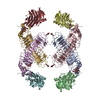
| ||||||||
|---|---|---|---|---|---|---|---|---|---|
| 1 | 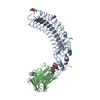
| ||||||||
| 2 | 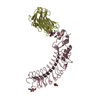
| ||||||||
| 3 | 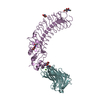
| ||||||||
| 4 | 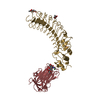
| ||||||||
| 単位格子 |
|
- 要素
要素
-タンパク質 , 2種, 8分子 ACEGBDFH
| #1: タンパク質 | 分子量: 39723.441 Da / 分子数: 4 / 変異: H355A / 由来タイプ: 組換発現 / 由来: (組換発現)  Homo sapiens (ヒト) / 遺伝子: LRRTM2, KIAA0416, LRRN2 / 細胞株 (発現宿主): Expi293F / 発現宿主: Homo sapiens (ヒト) / 遺伝子: LRRTM2, KIAA0416, LRRN2 / 細胞株 (発現宿主): Expi293F / 発現宿主:  Homo sapiens (ヒト) / 参照: UniProt: O43300 Homo sapiens (ヒト) / 参照: UniProt: O43300#2: タンパク質 | 分子量: 20953.354 Da / 分子数: 4 / 由来タイプ: 組換発現 / 由来: (組換発現)  Homo sapiens (ヒト) / 遺伝子: NRXN1 / 細胞株 (発現宿主): Expi293F / 発現宿主: Homo sapiens (ヒト) / 遺伝子: NRXN1 / 細胞株 (発現宿主): Expi293F / 発現宿主:  Homo sapiens (ヒト) / 参照: UniProt: P58400 Homo sapiens (ヒト) / 参照: UniProt: P58400 |
|---|
-糖 , 2種, 16分子 
| #3: 多糖 | 2-acetamido-2-deoxy-beta-D-glucopyranose-(1-4)-[alpha-L-fucopyranose-(1-6)]2-acetamido-2-deoxy-beta- ...2-acetamido-2-deoxy-beta-D-glucopyranose-(1-4)-[alpha-L-fucopyranose-(1-6)]2-acetamido-2-deoxy-beta-D-glucopyranose #4: 糖 | ChemComp-NAG / |
|---|
-非ポリマー , 3種, 10分子 




| #5: 化合物 | | #6: 化合物 | ChemComp-CA / #7: 水 | ChemComp-HOH / | |
|---|
-詳細
| Has protein modification | Y |
|---|---|
| 配列の詳細 | Sequence of Neurexin-1-beta was based on isoform 3b of database P58400 (NRX1B_HUMAN). |
-実験情報
-実験
| 実験 | 手法:  X線回折 / 使用した結晶の数: 1 X線回折 / 使用した結晶の数: 1 |
|---|
- 試料調製
試料調製
| 結晶 | マシュー密度: 4 Å3/Da / 溶媒含有率: 69.26 % |
|---|---|
| 結晶化 | 温度: 293 K / 手法: 蒸気拡散法, シッティングドロップ法 / pH: 6.8 / 詳細: 15% PEG 3350, 0.1 M sodium/potassium phosphate |
-データ収集
| 回折 | 平均測定温度: 100 K |
|---|---|
| 放射光源 | 由来:  シンクロトロン / サイト: シンクロトロン / サイト:  SPring-8 SPring-8  / ビームライン: BL41XU / 波長: 1 Å / ビームライン: BL41XU / 波長: 1 Å |
| 検出器 | タイプ: DECTRIS PILATUS 6M / 検出器: PIXEL / 日付: 2017年5月12日 |
| 放射 | プロトコル: SINGLE WAVELENGTH / 単色(M)・ラウエ(L): M / 散乱光タイプ: x-ray |
| 放射波長 | 波長: 1 Å / 相対比: 1 |
| 反射 | 解像度: 3.4→50 Å / Num. obs: 49781 / % possible obs: 96.3 % / 冗長度: 3 % / Rsym value: 0.105 / Net I/σ(I): 7.2 |
| 反射 シェル | 解像度: 3.4→3.46 Å / 冗長度: 2.5 % / CC1/2: 0.526 / Rsym value: 0.427 / % possible all: 93.1 |
- 解析
解析
| ソフトウェア |
| ||||||||||||||||||||||||||||||||||||||||||||||||||||||||||||||||||||||||||||||||||||||||||||||||||||||||||||||||||||||||||||||
|---|---|---|---|---|---|---|---|---|---|---|---|---|---|---|---|---|---|---|---|---|---|---|---|---|---|---|---|---|---|---|---|---|---|---|---|---|---|---|---|---|---|---|---|---|---|---|---|---|---|---|---|---|---|---|---|---|---|---|---|---|---|---|---|---|---|---|---|---|---|---|---|---|---|---|---|---|---|---|---|---|---|---|---|---|---|---|---|---|---|---|---|---|---|---|---|---|---|---|---|---|---|---|---|---|---|---|---|---|---|---|---|---|---|---|---|---|---|---|---|---|---|---|---|---|---|---|---|
| 精密化 | 構造決定の手法:  分子置換 分子置換開始モデル: 5Z8X,3B3Q 解像度: 3.4→49.815 Å / SU ML: 0.44 / 交差検証法: FREE R-VALUE / σ(F): 1.99 / 位相誤差: 24.64 / 立体化学のターゲット値: ML
| ||||||||||||||||||||||||||||||||||||||||||||||||||||||||||||||||||||||||||||||||||||||||||||||||||||||||||||||||||||||||||||||
| 溶媒の処理 | 減衰半径: 0.9 Å / VDWプローブ半径: 1.11 Å / 溶媒モデル: FLAT BULK SOLVENT MODEL | ||||||||||||||||||||||||||||||||||||||||||||||||||||||||||||||||||||||||||||||||||||||||||||||||||||||||||||||||||||||||||||||
| 精密化ステップ | サイクル: LAST / 解像度: 3.4→49.815 Å
| ||||||||||||||||||||||||||||||||||||||||||||||||||||||||||||||||||||||||||||||||||||||||||||||||||||||||||||||||||||||||||||||
| 拘束条件 |
| ||||||||||||||||||||||||||||||||||||||||||||||||||||||||||||||||||||||||||||||||||||||||||||||||||||||||||||||||||||||||||||||
| LS精密化 シェル |
| ||||||||||||||||||||||||||||||||||||||||||||||||||||||||||||||||||||||||||||||||||||||||||||||||||||||||||||||||||||||||||||||
| 精密化 TLS | 手法: refined / Origin x: -21.4377 Å / Origin y: 23.7672 Å / Origin z: -3.8036 Å
| ||||||||||||||||||||||||||||||||||||||||||||||||||||||||||||||||||||||||||||||||||||||||||||||||||||||||||||||||||||||||||||||
| 精密化 TLSグループ | Selection details: all |
 ムービー
ムービー コントローラー
コントローラー




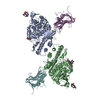
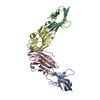
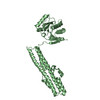
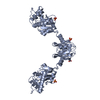

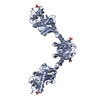
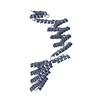
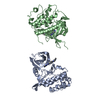
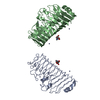
 PDBj
PDBj









